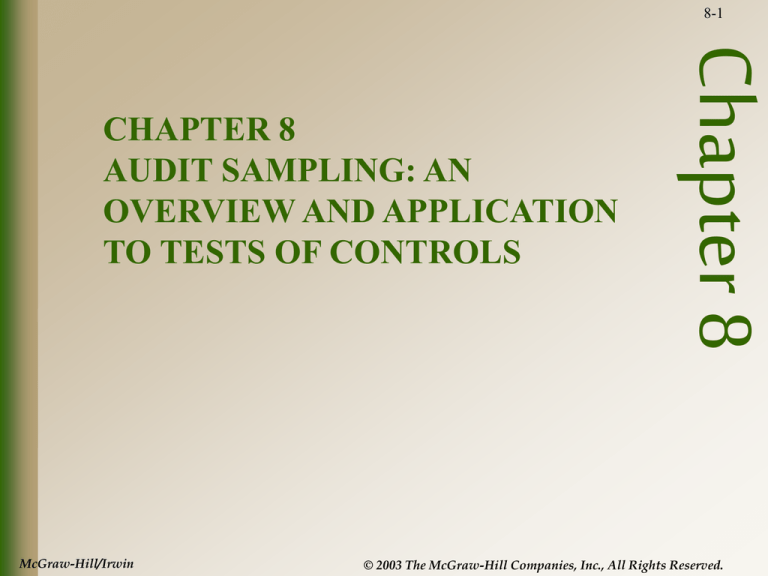
8-1
McGraw-Hill/Irwin
Chapter 8
CHAPTER 8
AUDIT SAMPLING: AN
OVERVIEW AND APPLICATION
TO TESTS OF CONTROLS
© 2003 The McGraw-Hill Companies, Inc., All Rights Reserved.
8-2
SAMPLING DEFINED
SAS No. 39 defines audit sampling as the application of
an audit procedure to less than 100 percent of the
items within an account balance or class of
transactions for the purpose of evaluating some
characteristic of the balance or class (AU 350.01).
McGraw-Hill/Irwin
© 2003 The McGraw-Hill Companies, Inc., All Rights Reserved.
8-3
AUDIT PROCEDURES THAT DO NOT
INVOLVE AUDIT SAMPLING
Inquiry and observation
Analytical procedures
Procedures applied to every item in the population
Classes of transactions or accounts not tested
Tests of automated IT controls.
McGraw-Hill/Irwin
© 2003 The McGraw-Hill Companies, Inc., All Rights Reserved.
8-4
TERMINOLOGY
Sampling Risk
Precision
McGraw-Hill/Irwin
© 2003 The McGraw-Hill Companies, Inc., All Rights Reserved.
8-5
TERMINOLOGY
Type I and Type II errors
Risk of assessing CR too high / Incorrect rejection
McGraw-Hill/Irwin
Risk of assessing CR too low / Incorrect acceptance
© 2003 The McGraw-Hill Companies, Inc., All Rights Reserved.
8-6
TYPES OF AUDIT SAMPLING
Nonstatistical Sampling
--Judgmental (may not be as effective)
Statistical Sampling
--Uses probability to select and evaluate sample
--Advantages:
Design efficient sample
Measure sufficiency of evidence
Quantify sampling risk
--Disadvantage: Cost of designing application and
training employees
McGraw-Hill/Irwin
© 2003 The McGraw-Hill Companies, Inc., All Rights Reserved.
8-7
SAS 39 Requirements
Planning for Sample Application
Relationship of sample to objective of test
Maximum deviation rate that would support planned
level of CR
Risk of incorrect acceptance
McGraw-Hill/Irwin
© 2003 The McGraw-Hill Companies, Inc., All Rights Reserved.
8-8
SAS 39 Requirements
Sample Selection (representative of population)
Random Number
Systematic
Haphazard
McGraw-Hill/Irwin
© 2003 The McGraw-Hill Companies, Inc., All Rights Reserved.
8-9
SAS 39 Requirements
Performance Evaluation
Consider effect of not being able to apply a planned
audit procedure to a sample item
Project results to entire population
Give consideration to sampling risk
Consider qualitative aspects of misstatements
McGraw-Hill/Irwin
© 2003 The McGraw-Hill Companies, Inc., All Rights Reserved.
8-10
TYPES OF AUDIT SAMPLING
Types of statistical sampling techniques
Attribute sampling
Monetary-unit sampling
Classical variables sampling
McGraw-Hill/Irwin
© 2003 The McGraw-Hill Companies, Inc., All Rights Reserved.
8-11
ATTRIBUTE SAMPLING APPLIED TO
TESTS OF CONTROLS
Attribute Sampling: Estimates the proportion of a
population that possesses a specified characteristic.
Normally used in tests of controls (determine the
operating effectiveness of a control procedure in
terms of deviations from the prescribed internal
control).
McGraw-Hill/Irwin
© 2003 The McGraw-Hill Companies, Inc., All Rights Reserved.
8-12
PHASES IN AN ATTRIBUTE
SAMPLING APPLICATION
McGraw-Hill/Irwin
Planning
Performance
Evaluation
© 2003 The McGraw-Hill Companies, Inc., All Rights Reserved.
8-13
PLANNING
Determine the tests objective(s).
Define the control deviation conditions.
Define the population.
Define the period covered by the test.
Define the sampling unit.
McGraw-Hill/Irwin
© 2003 The McGraw-Hill Companies, Inc., All Rights Reserved.
8-14
PLANNING
McGraw-Hill/Irwin
Determine sample size:
Determine acceptable risk of assessing CR too
low.
Determine tolerable deviation rate.
Determine expected population deviation rate.
Consider effect of population size.
© 2003 The McGraw-Hill Companies, Inc., All Rights Reserved.
8-15
Effect of Sample Selection Factors on
Sample Size (Table 8-4)
Factor
Relationship to Sample Size
Acceptable risk of assessing
CR too low
Inverse
Tolerable deviation rate
Inverse
Expected population deviation rate
Direct
Population size
No effect
McGraw-Hill/Irwin
© 2003 The McGraw-Hill Companies, Inc., All Rights Reserved.
8-16
PERFORMANCE
Randomly select the sample items.
Perform the audit procedures.
McGraw-Hill/Irwin
© 2003 The McGraw-Hill Companies, Inc., All Rights Reserved.
8-17
SPECIAL SITUATIONS IN PERFORMING
THE AUDIT PROCEDURES
Voided documents.
Unused or inapplicable documents.
Inability to examine a sample item.
Stopping the test before completion.
McGraw-Hill/Irwin
© 2003 The McGraw-Hill Companies, Inc., All Rights Reserved.
8-18
EVALUATION
Calculating the sample results.
Performing error analysis.
Drawing final conclusions
McGraw-Hill/Irwin
© 2003 The McGraw-Hill Companies, Inc., All Rights Reserved.
8-19
Nonstatistical Sampling
Differences in 3 Steps
1. Determine Sample Size: Use professional judgment,
not a statistical formula. Public firms establish guidelines
(Below Max – 10 - 15; Moderate – 20 - 35; Low – 30 - 75)
2. Random Selection: Allows use of haphazard samples
3. Calculating Results: Difficult to consider effect of
sampling risk
McGraw-Hill/Irwin
© 2003 The McGraw-Hill Companies, Inc., All Rights Reserved.





